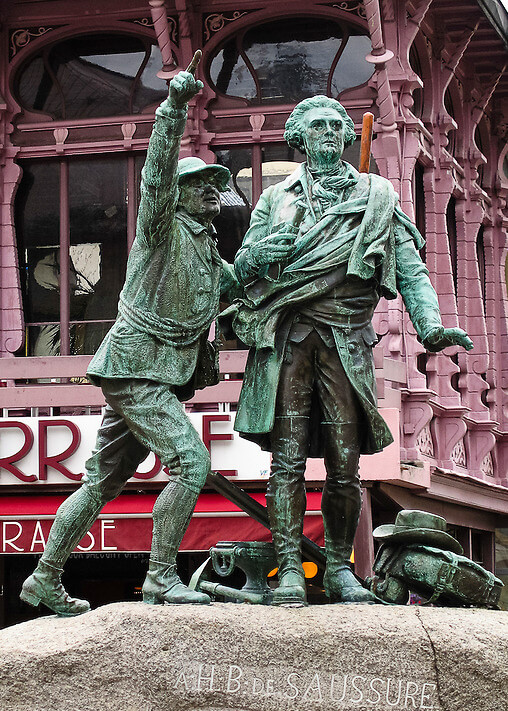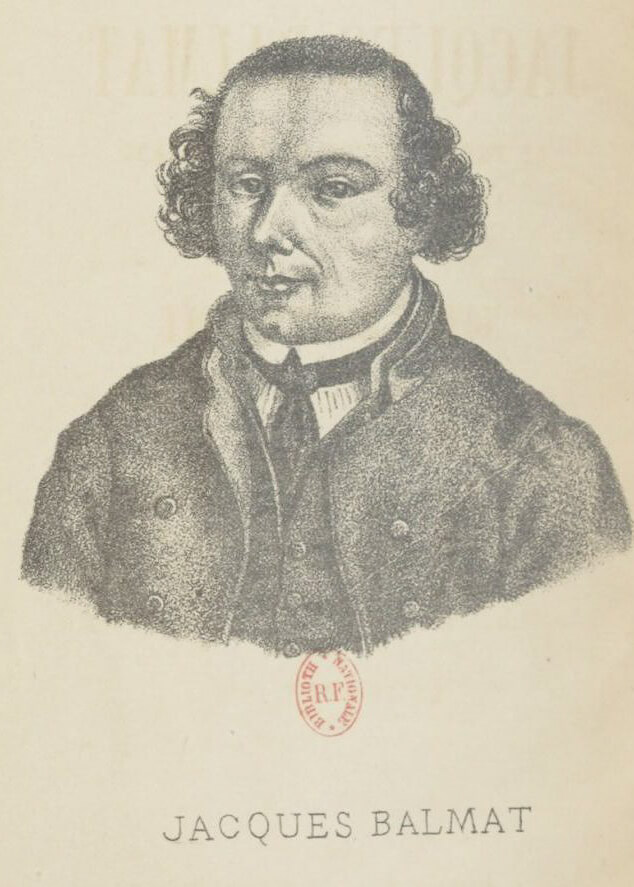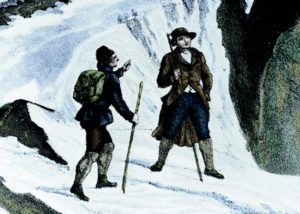Jacques Balmat or “Mont-Blanc” was born in 1762 in the Chamonix Valley.
On August 8, 1796, with his partner, Dr Michel-Gabriel Paccard, he marked history with the first ascent of Mont-Blanc.
Jacques Balmat lead Horace-Bénédict de Saussure at the top of the mountain the following year.
He was a chamois and crystal hunter but above all things a man in love with Chamonix’s mountains. He participated in creating the famous “Compagnie des Guides” in Chamonix, being one of the first guides.
Adding to the legend, he died from a mysterious death.
From hunting quartz to hunting the highest mountain in Europe
Jacques Balmat was born on January 19, 1762, in the hamlet of “Les Pélerins”, in the Chamonix valley. Two years earlier, Horace-Bénédict de Saussure, contemplating the Mont-Blanc, had promised a reward for the one who would find a way to the top of the mountain.
Balmat was born in a family of peasants. The peasant life is hard in the valley: harvesting weak crops because of the altitude and the steep terrain, managing the transhumance every year, cutting wood… “Balmat” is a fairly common name in the area, but Jacques Balmat was different. He was educated and knew how to read and write.
He was a chamois and crystal hunter. While he had a reputation (he sold a quartz mineral to Goethe in 1779), what he could earn from those activities was not enough to support his family. Attracted by the Saussure’s challenge and reward, he decides to put his skills to another objective: climbing Mont-Blanc.
Jacques Balmat’s revelation and the first ascent
One day, he bumps into a group of 3 climbers who are going to bivouac at la Montagne de la Côte. They are on their way to join two other guides, from St Gervais, at the summit of the Aiguille du Gouter.
Balmat joins them. Despite their reluctance, Jacques Balmat pushes them to the Dôme du Gouter, then towards the Mont-Blanc’s summit. Balmat finds himself astride on a very exposed ridge, only to realise that his group had abandoned him. He decides to turn back.
As it is too late to go back to the camp, he is forced to spend the night on the glacier, stomping his feet to make sure they do not freeze. While this seems like an endless and painful night, he grows from it: he learns that one can spend the night on a glacier and he now knows that Mont-Blanc is within his reach.
He starts looking for a partner. He chooses Dr Paccard, who treated his daughter before. Balmat knew he was an experienced alpinist. Michel-Gabriel Paccard quickly agrees.
They decide to be very discreet about their plans and agree to go their separate way and meet at the bivouac on Montagne de la Côte. For their ascent, they had neither a rope nor an ice axe nor crampons. Their only tool is an Alpenstock, a long wooden pole. They are also carrying a load of scientific equipment including a barometer, a thermometer, and a telescope.
On August 8, 1786, they left the bivouac around 4 am. At 6:23 pm, they reach together the top of “la Taupinère” (“molehill”) as Balmat used to call Mont-Blanc. Paccard made sure that two witnesses followed them from the valley using a telescope. He also takes his time to take some measurements. It is 6:57 pm when the two men leave the summit.
On the way down, Paccard loses the hat that protects him against the sun. Helped by Balmat, he will arrive almost blind in the valley.


The end of the Balmat / Paccard friendship and the second ascent
The account of the first ascent of Mont Blanc was progressively mis-told and manipulated to promote one man (Balmat) and belittle his companion (Paccard).
The instigator of this misrepresentation was Marc-Theodore Bourrit, another Alpine traveller who had himself failed to find a route to Mont Blanc’s summit and who wrote accounts of the successful ascent denigrating the role Paccard played and promoting Balmat as the “braver and fitter” leader. In fact, it had been Paccard who was the leader of the two and who reached the summit first. Sadly, the damage was done by now, and Balmat continued to boast in a conceited way about his part in the ascent, and Chamonix chose to believe him. This broke up the Paccard/Balmat friendship.
It belonged to Balmat to lead Saussure to the summit on August 3, 1787. He will find there his true consecration. The King of Sardinia (Chamonix belonged to the kingdom of Sardinia) award him the name “Balmat le Mont-Blanc”. This gives him strong notoriety.
Despite his new status, Balmat will not change his way of life. He will climb Mont-Blanc 11 times, with clients as a guide or for his own pleasure. He will lead Marie Paradis in 1809 to the top of the mountain. She will become the first woman to climb the highest mountains in the Alps successfully.
Jacques Balmat climbs Mont-Blanc, for the last time, in 1817. In 1821 when the “Compagnie des Guides de Chamonix” is created, his name is the first of the 34 guides.
He dies in the mountain at 72 years old. Nobody will ever find his body.


